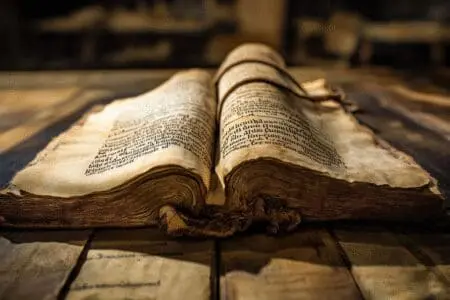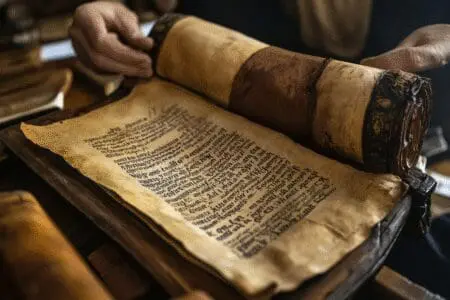Have you ever heard someone claim that Martin Luther, the great Reformer, took a pen and just slashed entire books out of the Bible? It’s a shocking thought. For those of us who cherish God’s Word, the idea that a man, even a famous one, could just remove parts of it is deeply unsettling. I remember the first time I heard it; I was in a Bible study, and the question hung in the air, making everyone a little uncomfortable. The question, Did Martin Luther remove books from the Bible?, deserves a real, honest answer.
The short answer is no. But the full story is a bit more complex and honestly, far more fascinating. It’s a story about history, language, and a passionate desire to get back to the purest sources of our faith. It’s not a story of subtraction, but one of re-organization based on deeply held convictions.
Let’s walk through this together. We’ll peel back the layers of history to see what really happened. My goal here isn’t to start an argument, but to bring clarity and peace to a question that can trouble the hearts of believers.
More in Bible Category
Why Is Sirach Not in the Bible
Where Should I Start Reading the Bible
Key Takeaways Before We Dive In
For those who want the quick highlights, here’s what you need to know:
- He Didn’t Remove Them: Martin Luther did not remove books from the Bible. He moved a collection of books, often called the Apocrypha, into a separate section between the Old and New Testaments.
- His Reasoning Was Historical: Luther wanted the Old Testament to match the original Hebrew Bible, which did not contain these extra books. His focus was on the principle of Sola Scriptura—Scripture alone.
- He Valued the Books: He didn’t think the books were useless. He wrote that they were “useful and good to read” for historical and moral insight, but not for establishing core Christian doctrine.
- Publishers Made the Final Change: Over time, Protestant Bible publishers stopped including the Apocrypha section to save money on printing costs and make the Bibles smaller. This gradual change, not a single act by Luther, led to the Protestant Bible we have today.
What Did the Bible Look Like Before Martin Luther?
It’s easy for us to think of the Bible as a single book that has always existed in its current form. But that’s not quite how it worked for much of church history. For the first 1,500 years of Christianity, the list of books included in the Bible—what scholars call the “canon”—was a topic of discussion.
Think about the early church. They didn’t have printing presses or online book stores. Scrolls and manuscripts were copied by hand, and different regions sometimes had slightly different collections of texts.
The Influence of the Septuagint
A huge piece of this puzzle is a translation known as the Septuagint. This was a Greek translation of the Hebrew Scriptures (the Old Testament) completed centuries before Jesus was born. It was incredibly important because Greek was the common language of the time.
Here’s the key part: the Septuagint included a number of books that were not in the original Hebrew Bible. These are the books we’re talking about today. The early church, which was largely Greek-speaking, read and valued these texts. This is why they were a part of the Bible for so many Christians for so long.
The Question of the Canon
So, for centuries, the Christian world had a collection of Old Testament books that was based on this Greek translation. However, some early church fathers, like the great scholar Jerome, pointed out a difference. Jerome, who translated the Bible into Latin (creating the Vulgate), noted that the Jews did not consider these extra books to be divinely inspired Scripture. He preferred the Hebrew canon but was overruled, and the Latin Vulgate ultimately included them.
This shows that long before Luther, there was an awareness of two different Old Testament canons:
- The shorter Hebrew canon.
- The longer Greek (Septuagint) canon.
This wasn’t a crisis for the church, but the distinction was there. The ground was already set for the questions Luther would later ask.
Who Was Martin Luther and Why Did He Care So Much?
To understand Luther’s actions, you have to understand his heart. Martin Luther was a German monk and theology professor in the early 1500s. He was a man consumed by a love for God and a desperate desire to know he was saved.
His breakthrough came from studying the Bible, specifically the book of Romans. He realized that salvation wasn’t earned through good works or church rituals, but was a free gift of God’s grace, received through faith in Jesus Christ alone. This changed everything for him.
Because Scripture had set him free, he believed it was the ultimate authority for all Christians. This principle, known as Sola Scriptura (“Scripture Alone”), became a central pillar of the Protestant Reformation. He believed that the Word of God was the only infallible guide for faith and life, standing above the traditions of the church or the decrees of popes.
What Are the Books at the Center of This Debate?
So, which books are we actually discussing? They are often called the Apocrypha or the Deuterocanonical books. What you call them depends on your church tradition.
The word “Apocrypha” means “hidden things.” This is the term Protestants generally use. The term “Deuterocanonical” means “second canon.” This is the term Catholic and Orthodox Christians use, signifying that their status was debated but ultimately affirmed.
Here are the primary books in question:
- Tobit
- Judith
- Wisdom of Solomon
- Ecclesiasticus (also called Sirach)
- Baruch
- 1 and 2 Maccabees
- Additions to the books of Esther and Daniel
These books contain history, wisdom literature, and stories. For example, 1 Maccabees is an incredible historical account of the Jewish revolt against the Greek Empire—the very events that led to the celebration of Hanukkah.
What Did Luther Actually Do with These Books?
This brings us to the main event. When Martin Luther translated the Bible into German, he wanted to make it accessible to everyone. It was a monumental task, and as he worked, he had to make decisions based on his Sola Scriptura principle.
When he got to the Old Testament, he faced the question of the Apocrypha. He knew these books were in the Septuagint and the Latin Vulgate, which the church had used for over a thousand years. But he also knew they were not in the Hebrew Bible—the Scriptures of the ancient Israelites.
His solution was a careful middle ground. He did not throw the books out. He did not declare them heretical.
Instead, he took them out of their scattered positions within the Old Testament and gathered them together. He placed them in a new, separate section between the Old and New Testaments. He gave this section the title “Apocrypha.”
Why Did He Move Them Instead of Removing Them?
Luther included a famous preface explaining his decision. He wrote: “Apocrypha—that is, books which are not regarded as equal to the holy Scriptures, and yet are profitable and good to read.”
His reasoning was twofold:
- Adherence to the Hebrew Canon: Since the Old Testament was originally the Scripture of the Jewish people, he believed it was right to follow the canon they had preserved. He felt this was a more authentic and original version of the Old Testament.
- New Testament Precedent: Luther and other Reformers noted that Jesus and the New Testament authors quoted extensively from the Old Testament, but they never once quoted from any of the Apocryphal books. This seemed to suggest that they did not view them with the same scriptural authority. For more on this, you can explore resources from institutions like Concordia Seminary, which delve into the canonical discussions of that era.
This was not a radical act of removal. It was a scholarly and theological act of re-categorization. He was trying to be faithful to history and to the principle that Scripture should be the church’s ultimate guide.
How Did We End Up with Different Bibles Then?
Luther’s Bible, with its separate Apocrypha section, became the model for many other Protestant translations, including the first English Bibles like the Coverdale Bible and the Geneva Bible. Even the original 1611 King James Version included the Apocrypha in the middle!
So if Luther and even the KJV translators included these books, why aren’t they in my Bible today?
The Catholic Church Responds
The Protestant Reformation caused a massive stir in the Christian world. The Catholic Church responded by convening a council to address the Reformers’ challenges. This was the Council of Trent (1545-1563).
At this council, the Catholic Church made an official, binding declaration on the biblical canon. They affirmed the longer Old Testament canon, including the Deuterocanonical books, as inspired Scripture. This decision solidified the canon for the Catholic Church from that point forward, making the difference between the Catholic and Protestant Old Testaments official.
The Printers Make the Final Cut
The final step in the journey happened for a very practical reason: money.
In the centuries after the Reformation, Bibles were being printed for the common person. Paper and printing were expensive. Including an entire extra section of books added significant cost and bulk to a Bible.
Bible societies and publishers, especially in the 19th century, began printing Bibles without the Apocrypha section to make them more affordable and portable. Since most Protestants already considered these books secondary, there wasn’t a major outcry. Over time, it just became the new standard.
So, the books weren’t removed by a theologian in a furious debate. They were quietly left out by printers looking to make the Word of God more accessible to everyone.
What Does This History Mean for My Faith Today?
Learning about this history can feel a bit jarring. It’s okay if it does. I remember digging through all this for the first time and feeling a little overwhelmed. It’s like finding out something about a dear old friend you never knew.
But here’s what I’ve come to realize: this historical debate doesn’t have to shake our faith. In fact, it can strengthen it.
First, it shows us how deeply people cared about Scripture. Luther wasn’t trying to weaken the Bible; he was trying to honor it in the most faithful way he knew how. The entire debate was driven by a passion for the Word of God.
Second, the core of our faith remains untouched. Not a single core doctrine of Christianity is based on the Apocryphal books. The story of creation, the fall of man, the promise of a Messiah, the life, death, and resurrection of Jesus Christ, and the promise of salvation by grace through faith—all of it is found clearly and completely in the books that all Christians agree on.
I once had a conversation with a dear Catholic friend about this. We talked about the differences in our Bibles, and it was a beautiful, respectful discussion. We realized that we both loved the same Jesus, we both trusted in his sacrifice, and we were both trying to live lives that honored God. The foundation we shared was so much bigger than the section of books where we differed.
Should I Read the Apocrypha?
My answer is an enthusiastic “yes!” Just as Luther said, they are “profitable and good to read.”
Reading them can give you incredible insights into the world Jesus lived in. The stories of Jewish history in 1 and 2 Maccabees provide crucial context for the New Testament. The wisdom literature, like the book of Wisdom or Sirach, contains beautiful and profound sayings.
Read them for what they are: important historical and spiritual documents that were part of the Christian heritage for centuries. You don’t have to read them as divinely inspired Scripture to benefit from their wisdom and history. You can read them to better understand the rich soil in which the New Testament grew.
Conclusion: A Story of Re-Organization, Not Removal
So, did Martin Luther remove books from the Bible? No.
He found a library with a disorganized shelf. He looked at the books, studied their origins, and decided to group them in a way he felt was more historically accurate and theologically sound. He created a special section for these important, but secondary, texts. He left them for us to read and benefit from.
Centuries later, publishers stopped printing that special section.
This story isn’t about a man trying to delete God’s Word. It’s about a man so dedicated to God’s Word that he wrestled with history to present it faithfully. The Bible we hold today is a testament to that legacy of reverence. The message of God’s love for us in Jesus Christ has been preserved, and it remains as powerful and life-changing today as it was in Luther’s time.
Frequently Asked Questions – Did Martin Luther Remove Books from the Bible

What was the Catholic Church’s response to Luther’s translation and the Reformation?
The Catholic Church held the Council of Trent, which reaffirmed the canonicity of the Apocryphal/deuterocanonical books, explicitly stating that they are sacred Scripture, thus solidifying the official biblical canon for Catholics.
How did Luther’s translation influence later Protestant Bibles?
Luther’s translation set a precedent by placing the Apocrypha in a separate section, a format followed by many early Protestant Bibles. Over time, economic reasons led to the removal of these books from most Protestant editions, not because of doctrinal rejection.
Why did Luther place the Apocryphal books in a separate section?
Luther placed the Apocryphal books in a separate section called ‘Apocrypha’ because he believed they were useful to read but not equal in authority to the Bible’s main texts, based on his principles of Sola Scriptura and returning to the original sources.
What was the status of the Apocryphal books before the Reformation?
Before the Reformation, the Apocryphal books were included in the Latin Vulgate and widely read by Christians, but their status as equal to Scripture was uncertain, and even scholars like St. Jerome questioned their authority.




